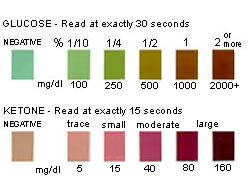 Closeup of the bottle chart
Closeup of the bottle chart
These are reliable for four months after opening not until expiry date.
They have six readings on the bottle for glucose as follows.:
Blue
which is negative.
Pale Green which is trace or 1/10.
Dark Green which is 1/4 (means positive)
Light Brown which is 1/2 (means positive)
Medium Brown which is 1 (means positve)
Dark Brown which is 2 or more (means very positive)
 comparing dipped
urine strip to the bottle
comparing dipped
urine strip to the bottle
The top is the glucose present in urine and bottom of strip is ketones
present.
Both are negative in this example. Timing is important I catch the
urine in a cup and test when I come in the house.
They
have six readings on the bottle for ketones as follows:
Brown which is negative.
Pale Pink which is trace (5 mg/dl)
Dark Pink which is small (15 mg/dl)
Pale Purple which is moderate (40 mg/dl)
Medium Purple which is large (80mg/dl)
Dark Purple which is large (160 mg/dl)
Tyler's first vet thought it was ok for Tyler's urine readings to be 1/2
to 1 percent
using the Diastix. When he was taken for a checkup (usually in the
morning two
hours after his shot) his BG reading was usually in the 300+ range-which
meant
to her that his readings could go as high as 500 and the lows were not
much
below 200.
Tyler's present vet wants his urine samples to be negative all the time.
His theory is if you increase the insulin until you hit negative and than
back off
a unit or 1/2 unit until you get glucose 1/10 to 1/4 than the dosage you
were at
was the correct dosage (at negative).
The internist Tyler saw felt Linda should let him show a little glucose
1/10 to 1/4
(light or medium) ( Linda uses clinistix). He had done a 24 hour
glucose curve
and the readings ranged from highs of 128 to a low of 71. He felt
Linda might
overdose him on insulin. However this was not an accurate curve because
Tyler does not eat away from home. Linda's vet and Linda realized
this and
knew the true values would of been in the normal range under different
conditions.
She
tried the internist's method and he did an 8 hour curve a month later.
Tyler's BG shot up to a high of 320 and low's in the 200 range so Linda
went
back to her vet's method.
This method work's best for Linda but she feels you do need cuves done
to actually see if the method you are using is working and know the limitation
as well as common sense when urine testing.
Large or Medium size dog---->over 30 pounds
4+ (2%)-------------------------------increase 2 to 3 units over previous
days dose
3+ (1%)-------------------------------increase by 2 units
2+ (1/2%)----------------------------increase by 1 unit
trace (1/10%)or 1+ (1/4%)----no change
negative----------------------------decrease dose by 2 units
For a cat or small dog<-----under 30 pounds
4+ (2%) or 3+ (1%)---------------increase by 1/2 unit to 1 unit
2+ (1/2%)----------------------------increase by 1/2 unit
Trace (1/10%) or 1+(1/4%)---no change
Negative----------------------------decrease dose by 2 units
She was told the ultimate objective was to maintain at the trace to1+ level.
In small animals it was suggested that the above changes were to be made
on an alternate day method.
She modified the "small" scale for her dog, Cody----after a few weeks,
she
started making all the changes in 1/2 unit increments---he seems to stay
on a more stable dose this way (She did tell her vet what she did and he
agreed). She now uses a combination of her modified urine scale and
does home blood glucose curves.
From the results of these glucose assessments, the insulin dose can
be adjusted.
Results of Urine Testing from caninsulin manual
| First Test | Second Test | Third Test | Dose Adjustment |
| trace | negative | negative | none:correct dose |
| trace | negative | positive | none: correct dose |
| positive | negative | negative | none: correct dose |
| positive | positive | positive | +10%: dose too low |
| negative | negative | negative | -10%: dose too high |
| positive | negative | positive | -20%: Somogyi effect |
When a urine test is positive, this means that sometime since the animal
last urinated that glucose has spilled over into the urine. Therefore
it is
best to let the animal pee and then try to catch another sample in a half
an hour and this will better reflect the glucose status. If the dog
had not
peed for 8 hours you would have an 8 hour pooling of urine in the bladder.
I follow Queenie outside with a little punch glass and catch her urine
,
bring it into the house and test it. Might be a little harder to
do with a
male dog and a cat. The first week she used to quit peeing when I
stuck
the glass under her but now she could care less.
With Queenie, I have also found that I rinse the hair in her tush area
after
each urination because the hair is long in this area and I did not want
dried urine containing glucose that could contaminate the next specimen.
I just have a gallon of water outside and rinse the area with the water
and
my hand.(I am a dedicated owner).